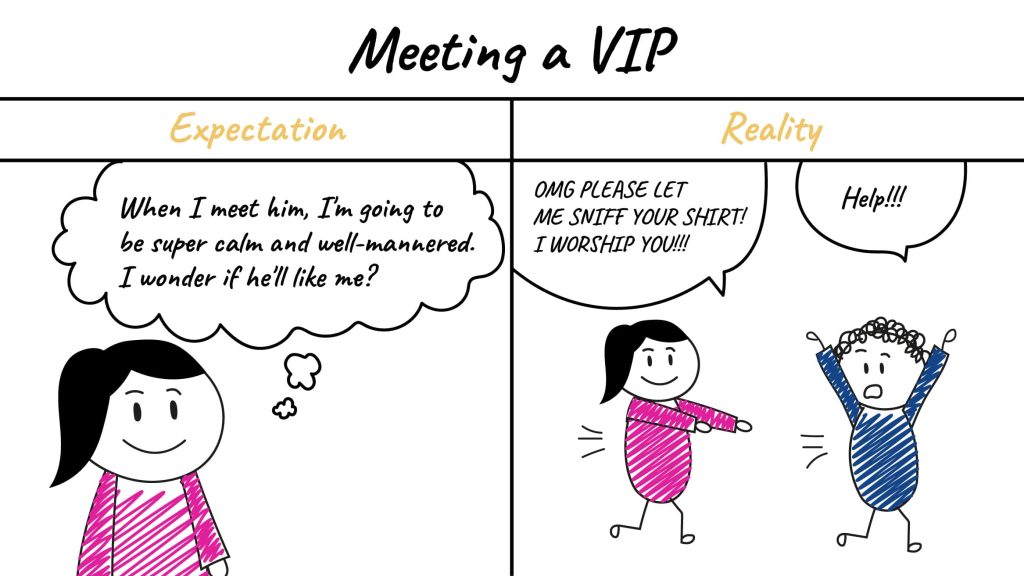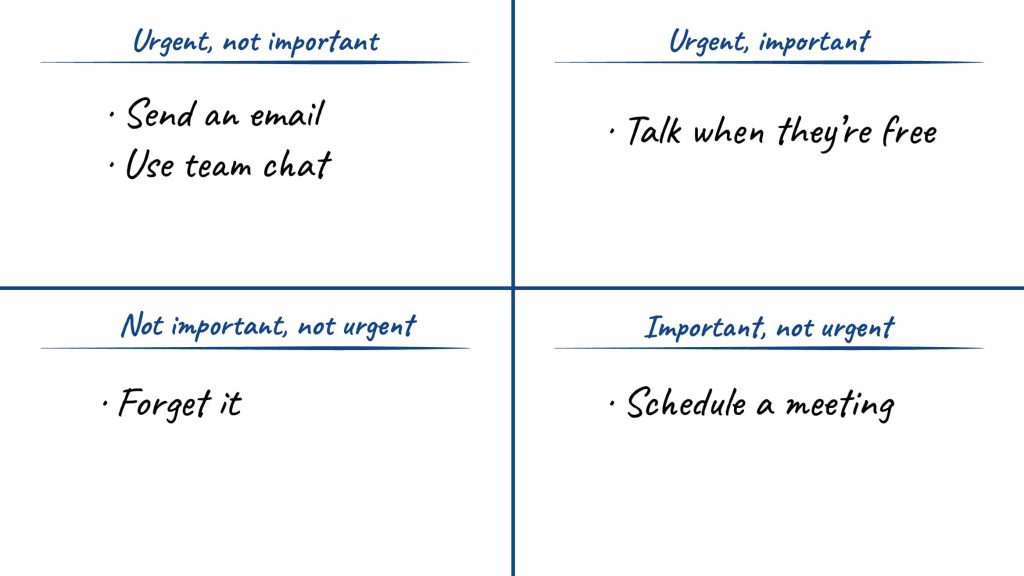Believe it or not, I get this question a LOT from my readers:
“Hey, Vanessa! I’m going to meet this movie star/CEO/the president. How the heck do I talk to them!?”
I’ve had the opportunity to talk to countless VIPs across a variety of industries. And sometimes I am a semi-VIP at my speaking events (like my TED talk!).
Here, I’ve broken down my top tips for you:
- What is a VIP? (Definition)
- 8 important tips that can make or break any VIP interaction
- The 8 types of VIPs you’ll encounter in the workplace (and how to deal with them)
Let’s dive straight in.
What Does VIP Mean? (Definition)
VIP stands for Very Important Person. They’re usually the most important person (or people) in the room and are often admired or respected by others. VIPs can be comedians, actors, bosses, government officials, wealthy people, or anyone else that gets preferential treatment for holding a particular status.
8 Unique Tips to Talk to VIPs
Even if you’re not a VIP, I can teach you how to confidently talk to VIPs.

That being said, I’ve made a lot of mistakes learning this communication art. Here’s what I’ve learned works best when dealing with VIPs (step #3 is my favorite):
Step #1: The Urgent/Important Matrix
Would you bend over to pick up a dollar?
Now, you’ve probably heard this before, but if that dollar was right in front of Bill Gates…
he would NOT pick it up. Even if there were $44,999 more dollars right in front of him.
That’s because, according to Neil deGrasse Tyson, Bill Gates’s time is worth more than the time it would take to literally pick up tens of thousands of dollars.
Bizarre.
You should take this same mindset with VIPs, especially those in your workplace like CEOs and the company president.
Time is money, and the time you spend with VIPs should make them feel like gold.
VIPs are constantly busy, and if you can save them even a minute, then you’re already ahead of the game. So I want you to ask yourself the following question:
Do I need to talk to them in person?
If you’re already scheduled to meet them, or stumble upon a VIP at a cocktail party, then great…
But if you’ve got to jump through 10 flaming hoops for a simple 2-minute chat, then it may be better to opt for a different method of communication.
Try the Urgent/Important matrix:

The bottom line is:
Time is money for VIPs.
Make your time with them worthwhile.
Step #2: Do Your Homework
How well do you know your VIP?
One of the biggest hurdles to a great VIP interaction is not knowing what to talk about. How many times have you had a conversation that was a little awkward?
Let’s avoid this.
Finding common ground lets you have topics to be passionate about while also avoiding any potential hiccups… like that one time a reporter confused Samuel L. Jackson with Lawrence Fishburne. Yikes.
You’ve got to find common ground with a VIP, and this means being a serial investigator:
- browsing their Facebook, Instagram, and LinkedIn
- reading their books
- listening to their podcasts
- checking out their website
- knowing their backstory before they became famous
- any recent changes in their life/work/relationships
Tom Bilyeu, the host of Impact Theory, is a GREAT example of someone who knows how to talk to VIPs. He constantly has VIPs on his show, like Seth Godin, Ramit Sethi, and even me!
You can just hear how well he knows every single VIP from the grand introduction he gives. Aim to be like Tom. VIPs can clearly tell who’s done their research, and you may even impress them with your initiative.
You can check out our episode here:
Step #3: The Approach
How do you even approach a VIP?
Many times, you’ll find the VIP talking with others. The key here is to identify what kind of conversation they’re having. Is it business or personal?
- Business: If it’s business, skip it. It’s best to stay out of business conversations, unless they’re directly related to you, or you have an amazing solution to their problem.
- Personal: If they’re laughing away and having a blast, you’ve got to reciprocate or turn up that energy. Bringing to the table a lower energy is a surefire way to kill the mood, so the best way to enter is to bring up something relevant and keep that energy high.
If you’ve got the green light, great! Depending on the situation, you’ve got some options.
For example, let’s say the VIP looks like this:
The Solo VIP

If you find a VIP standing alone like a golden nugget in the middle of a desert, then congrats! You’ve hit the jackpot and can freely approach.
But most likely, the VIP will be surrounded by others.
The 2-way conversation

If they’re talking with one other person, this is the second-best scenario. I want you to scope out that other person—who are they?
- The fan: If the other person is a fan, great! You’re on equal footing. This is a great time to approach.
- The lover: If the VIP is in an established relationship, it should be easy to approach since they’re comfortable around each other. If it’s a VIP’s new date, they may be looking for intimacy and may be annoyed by others who approach.
- The business partner: If you overhear a deep discussion, with numbers and facts, it’s best to wait until they’re done talking to make your approach. Nobody likes their important discussions to be interrupted.
- The friend: If the two are talking like good friends, then it’s safe to assume they’re having a good time. Approaching with confidence is key to keep the energy levels high.
Are you ready to approach? The key is to approach from the side and in front, like this:

This avoids a head-on approach, since VIPs may find a frontal approach more intimidating. They can also see you from their peripheral vision, avoiding any surprise attacks. Make sure to not create a third wheel out of the other person—make an effort to include everyone in the group.
The Trio

If you find the VIP standing like he’s talking TO a group and not WITH them, most likely he’s the boss, or they’re not well-acquainted with each other.
Try one of these methods for your approach:
#1: The Team Member
This approach is inserting yourself directly in line with everyone else. This the safer play, although it gives you subordinate status. Do this if you want to blend in and build rapport with the entire group.
#2: The Sidekick

The sidekick method targets the VIP right away. Directly approach the VIP when there’s a break in the conversation, getting straight to the point. You can even divert attention away from the others in the trio by introducing yourself and saying, “I was hoping I could have a chat with you.” You likely won’t win any brownie points with the others with this approach; however, I’ve used this approach successfully to gain the attention of a famous blogger at a tech conference.
The circle

If the VIP is standing in a circle, it’s going to be harder to break in. There’s more equal status in a circle than in the trio setup, so your approach has to convey value and equal status in order to be effective—otherwise, it’s like jumping into a circle of wolves when you’re the sheep.
#1: The Slide-In

This is the safest way to insert yourself into a circle and the one that I recommend. This is my go-to strategy, and I’ve even used this many times to my success. You won’t stand next to the VIP—this shows that you’re not trying to win them over—but you’re close enough that you can easily get into a deep conversation with them anytime.
#2: The Buddy

The Buddy approach is great if you know the VIP already but don’t know anyone else in the circle. If the VIP doesn’t know you, you might come off as a little creepy or trying too hard.
#3: The Power Position

Joining the circle directly across from the VIP gives you a chance to win over the whole crowd. Keep in mind that being directly across from the VIP is a huge power play. I saw an office lady try to pull this off, but she got burned out because her nervousness sank the group’s energy like a rock. So if you’re going to take this position, make sure you’ve got the confidence and social skills to make a great impression.
The VIP Circle

Sometimes you’ll see a group of VIPs huddled together. Approaching a VIP circle takes rock-solid confidence and a good control of your nerves. You can use the other methods of approach above, but there’s also one that you may (or may not) want to consider:
The Crowd Pleaser

99.9% of the time, I wouldn’t recommend doing this. I’ve only seen this done ONCE (and it made the VIPs’ mouths drop open), and that was because the guy that was in the middle wowed the executives like David Blaine doing a fancy card trick. For most people, I would avoid jumping in the middle. But for the 0.1% that get it right? You’ll definitely make a lasting impression to remember.

This VIP is so important they’re surrounded by bodyguards… Do you really want to approach? Your best bet is likely sending an email or letter and not getting your hopes up.
Step #4: The Opening
Now that you’re “in,” how do you really nail the opening?
Do you go for a handshake or a hug?
What do you even say?
The opening is especially important since the first 7 seconds of an interaction is like a chemical dance of hormones and neurotransmitters in our brains…
Which means a VIP may already have a first impression of you (hopefully good) before you even open your mouth.
- The first line: Contrary to popular belief, it’s not so much WHAT you say but HOW you say it. That’s why asking the go-to “How are you?” question is actually a GREAT way to open a VIP if you’re having a 1-on-1… as long as the rest of your opening is good. And if you’re in a group, try to find a first line that incorporates everyone. If you can, try to organically insert yourself, such as saying, “Hey, my name is Vanessa! I couldn’t help but overhear you talking about…”
- Have a pocket question: This should be a question (or two, or three) you have armed and ready so you’ll be able to jump straight in. I recommend taking a look at 57 Killer Conversation Starters to get a good idea of non-boring questions to ask.
- Let them initiate: Often, we’ll be too excited or nervous and either invade their space or stay too far away, like a distant alien. Neither of these approaches work best. Let them decide if you’re going in for a handshake, hug, and how far apart to stand.
- Use your happy hello: Did you know people can identify your happy voice? Here at the Science of People lab, we conducted research and found that our mood can easily be registered by our vocal tone. Sound obvious? Well, during conversation, our voice naturally tends to go higher, making us sound squeaky. There’s an ideal range to our voice. You can learn this range over at our How to Speak With Confidence article.
Step #5: Launch and Mirror
OK, so you’ve introduced yourself—now you have to pay attention to what your body is saying.
After all, you DON’T want to commit a faux pas by engaging in one of the ABC behaviors:
- Annoying, like jumping up and down like a squeamish 12-year old at a Taylor Swift concert
- Blocking, like crossed arms
- Creepy, like asking them to sign your favorite pair of underwear
OK, assuming you’re normal, then the most important thing you have to worry about is blocking behaviors:
- Crossed arms. This is a natural “shield” you might do to protect your heart and chest area.
- Crossed legs. This is another shield for your rather… ahem, vulnerable bits.
- Covering eyes. You might touch your eyes if you’re especially nervous, but this signals you want the VIP to be “out of sight.”
Instead of these blocking behaviors, you’ve got to signal “Friend, friend, friend!” especially with your body.
So how do you signal you’re open and friendly? Stand in the Launch Position. Essentially, this includes making sure your toes are pointed toward a person, arms are relaxed, and shoulders are loose.
I detail everything you need to know about the Launch Position in my first impression guide.
Coupled with launching, you can use mirroring to instantly build rapport with anyone, especially VIPs.
Here, you can see mirroring in my interview on Short Long Story:
Special Note: Be subtle. It’s worse to be obvious than not mirror at all. Add a delay or do a slightly different gesture to not raise any red flags during the conversation.
Step #6: Be a Value Machine
For many people, this step is extremely hard. Especially since they’re so used to taking value rather than giving.
It might seem difficult, but ask yourself:
What value can I add for the VIP?
Do you have inside information? Or maybe you can just be funny or add some entertainment to an otherwise boring day?
And the key to being a value machine is to actually OWN what you say. Go 100%, and don’t settle for 50. Remember, YOU belong with the VIPs:
- Watch for uncertainty. Choose your words, and say them with conviction. Don’t say, “I think…” Instead, say, “There is…” Having confidence in your voice shows that you belong, and you’re not there to kiss the VIP’s feet.
- Treat them like a normal person. This is absolutely crucial when hanging around a VIP. VIPs get pampered all the time, and if you’re acting the same, you’re not going to stand out. Limit the compliments to genuine ones only, and control your excitement so you don’t act super giddy around them.
- Offer advice. This is a great way to show you have high self-confidence. Do you have a favorite movie? A preferred burger joint or travel destination? Freely give your advice to give value.
- Share stories. It might sound counterproductive, but you’ve got to share to have a 2-way conversation. What are you passionate about? Introduce the VIP to your own world so they can have a clearer idea of who you are.
- Don’t waste time. The #1 way to take away value—especially from VIPs—is to waste their time. I remember when I first started meeting VIPs, I would go on and on, just to avoid awkward silences… this is a huge mistake because I wasn’t getting to the point.
- Defer to others. If you’re in a group, make sure to include others. Compliment them, make them stand out—nobody likes the person who is a braggart, and everyone loves the person who gives compliments like candy.
- Ask them how you can help. In the end, being straightforward is something that takes courage… but surprisingly, it works. Most of the time, the VIP will ask for nothing in return, but they will see you as an ally and someone they can rely on.
Step #7: Master Small Talk
Hey, didn’t I say time is limited?
Believe it or not, VIPs also make small talk—especially if they’re at a social event and not in a rush.
If you catch yourself in a relaxed environment, you need to know how to relax, instead of going full-on business mode. (Pitching your CEO about a problem, when all they want to do is relax? Don’t be a mood killer!)
Recently, I even found a great conversation hack that Jerry Seinfeld uses! Check out the video below:
And to brush up on your small-talk skills, check out my guide on how to make and hold dazzling conversations.
Step #8: The Wrap-Up
So you’ve introduced yourself, and you’re both vibin’. Hooray!
Now comes the important part:
Telling them what you’re here for.
What’s the main point of the VIP meet-up? Perhaps you want to sell them with an elevator pitch. Or maybe you just secretly want to take his autograph and sell it on eBay.
Whatever the case, now’s the time to make it known. Get straight to the point, and talk about results before the processes.
Finally, it’s important to make a graceful exit… or you might ruin everything that’s built up to this point (and make sure to grab their contact info, if desired!).
Bonus #9: 10 Questions to Ask a VIP During a Meeting or Lunch
So you’ve got a nerve-wracking lunch session or meeting coming up with a VIP?
It doesn’t have to be that scary.
Being a VIP has its own perks: They’ve heard a lot and can usually tell who’s done their homework, simply by the questions they ask.
Here are the 8 best questions to make a great impression with a VIP (and 2 commonly asked questions to avoid):
#1: “What does your morning routine look like?”
Since most successful CEOs have a morning routine, asking about what he does before work is a great way to ask a unique, non-boring question. This question may also reveal a CEO’s personal values, as many people prioritize what they value and schedule it first thing in the morning.
#2: “How did you get to where you are today?”
I love this question because it shows 2 things:
- you’re interested in the VIP, and
- you’re ambitious and willing to learn.
And of course, if you’re a master of conversation, you’ll know that people LOVE talking about themselves. You’ll make your VIP feel important. You’ll learn about his background (if you haven’t already). And you’ll make a darn good impression, that’s for sure.
#3: “Where did you go to school?”
Unlike my CEO friend Mark’s story, most successful CEOs did attend college. This is a great conversation starter that will bring back memories of the CEO’s good ol’ university days. I find that most people love talking about their younger years (even if they were a bit awkward, like me), so this is a great question to get to know your CEO’s past.
#4: “What is your personal passion project?”
Not all questions should be business. This is one of my favorite questions to break the ice and get to know your CEO on a deeper level. Even though CEOs are mega busy these days, they still make time for their favorite hobbies and pastimes. And if you strike it lucky, you may even have hobbies in common!
#5: “What is the best and the worst part of being a CEO?”
This is another great question to pick the brain of the CEO while also getting to know their passions and struggles.
#6: “What’s your favorite outdoor activity?”
Who doesn’t love the great outdoors? Asking this non-boring question is a breath of fresh air, and stands out from those boring office-related questions.
#7: “Would you consider yourself more introverted or extroverted?”
Even if you think you can tell someone’s personality, sometimes a person’s own perception of their personality can be totally different than expected. For example, most people would assume I’m super extroverted since I run a people skills website—however, I’m naturally quite introverted at times and would consider myself a true ambivert. And who doesn’t love to talk about personality?
#8 “What’s the biggest challenge you’re facing right now?”
This one might sound negative, but it’s a great question to ask to let the CEO know you’re truly interested in their problems. Since talking about problems has been shown to release pent-up feelings, your CEO will appreciate you being a play therapist, too.
#9: (Don’t ask) “What is the company’s vision?”
I’ve gotten asked this question a lot, but it shows me the asker hasn’t done their homework. If you take a quick look at a CEO’s website or product, you’ll likely find the company’s vision within a few minutes of research. A better question to ask is “Where do you see the company in 5 years?”
#10: (Don’t ask) “How do you feel about [employee]?”
Believe it or not, I’ve been asked this question more than once. If you’re at lunch with a CEO, chances are you’re there to have a good time and talk about business and/or personal life, not gossip. If you really want to know a CEO’s true feelings, try reading their body language rather than directly asking.b
The 8 Types of VIPs You Will Encounter in the Workplace (and How to Deal With Them)
VIPs, like M&M’s, come in all shapes and sizes. Some are easier to get along with than others, but no matter how you approach them, there are certain strategies you can use to ensure your success… especially when it comes to VIPs you will constantly see in your workplace:
VIP #1: The Chief
The Chief is a hard one to win over. He’s been in the company long enough that he’s seen pretty much everything—nothing you say or do can affect him.
As a result, he’s driven by performance. Making small talk isn’t easy, and he doesn’t care how you act, as long as you’re making profit for the company.
Here’s how to get on his good side:
- Focus on the numbers. What metrics can you bring up in the conversation? Don’t go for “approximates”—give him straight hard numbers and facts. This will also go a long way since he’ll know you’ve done your homework.
- Skip the small talk. Unless the Chief likes personal talk, get straight to the point. The direct approach avoids a buildup—you want to get straight to the facts as soon as possible. For example, if you’ve got great news, state the result of the news, and avoid the details of how you got there. Remember: the Chief wants to see results, not necessarily the long process.
- Bring solutions to the table. There’s no use bringing up problems without a solution—this is just complaining. If you’ve got a problem, show initiative by finding a potential solution before bringing it to the executive’s attention.
VIP #2: The Friend
Have you ever had a boss that seems more like a friend than a boss?
She’ll often be the one suggesting games to play around the office. Anytime you see her, you’ll often see a bright smile on her face and plenty of people surrounding her.
The Friend thrives on social interaction, and it’s in your best interest to balance play with work:
- Let your personality shine. The Friend loves to tell stories about herself and her family. And she loves hearing stories, too! Take some time to give her updates on your personal life, crack a joke here and there, and make small talk to build a deeper connection.
- Start with an icebreaker. A simple “How are you?” might be fine but won’t win you any brownie points. Instead, always have an icebreaker or two on hand. This will spark dopamine in the conversation and also let you know more about her. For a list of questions to ask, check out 35 icebreakers to cool any conversation.
- Be straightforward. Remember, even though the Friend is warm and caring, she is also a busy executive. She’ll appreciate it if you get straight to the point without skipping around. This also means if you’ve got a lingering deadline, letting her know upfront before you talk your afternoon away is a great way to show initiative.
- Keep open lines. The Friend will especially love it if your communication channels are open. She may check up on you to see how you’re doing personally and professionally, and she’ll feel safe knowing she can message you to give you updates at a moment’s notice.
VIP #3: The Caveman
The Caveman is the type of executive who’s still using a typewriter instead of a Macbook (maybe a slight exaggeration, but still not too far off).
They’re traditional people stuck in their old, traditional ways, and any flashes of innovation or attempts to speed up old processes are often met with a simple grunt or flick of the hand.
With the Caveman, you need a more traditional approach:
- Play by the rules. I get it—you’re tired of being inefficient and behind. But since you’re not an executive (at least not yet), you’ve got to play by the old rulebook. And hey, their systems probably DO work, even if they’re a bit slower. Sometimes it’s best to just nod and comply.
- Introduce change… slooooowly. Have you ever heard of the foot-in-the-door technique? There’s a reason it’s not called the fully-slam-open-the-door technique. If you want to be innovative and up to date, try bringing in a new small process rather than a whole system. This will make it easier for the Caveman to digest.
- Don’t talk about change. The Caveman doesn’t like change or keeping up with the trends. Instead, you’ll often overhear him talking about how the “good ol’ days” were or how the catered lunch tastes like his mother’s cooking. Stick with older topics and avoid viral topics to relate with the Caveman.
VIP #4: The Robot
OK, now you’re stepping into the hard territory. The Robot is the type of boss who seems to stare into the abyss of your soul whenever you talk to him.
And it’s not like you don’t try to connect with him, it’s just that there’s something a little… off.
Eek!
Just like Sun Tzu’s The Art of War, his motto is “The supreme art of war is to subdue the enemy without fighting.”
Here’s how to overcome a boss that gives you the creeps:
- Move. Take a walk to the other side of the office, the water cooler, or simply make circles while talking to him. This breaks up his stare and introduces change to the normally rigid conversation.
- Don’t fill the void. If the Robot stays silent, don’t feel the need to give up more information just for the sake of it. Stare back, stay in that silence, and stand your ground.
VIP #5: The Scrooge
Ugh, the Scrooge is the executive that tries to run the company like he owns the place.
Even if he does, nobody likes him. He’s loud, voices his complaints, and micromanages to a tee. And he works overtime just so he can avoid his wife at home.
But the truth is:
The Scrooge just loves power.
Here’s how to fight fire with fire:
- Stay strong. Stare back and remain calm. Like a hungry tiger, if he sees terror in your eyes, he WILL strike. Give it to him plain and simple, and know that this may be just a “test” to see if you’ll crack.
- Inflate his ego. Sometimes, you won’t be able to fight. In these cases, fill the Scrooge’s ego by making him look good. Give him compliments, make him look good in front of his peers, bring up the times he did a good job. Remember: this does NOT mean accepting abuse. If you feel like he’s gone too far, it might be best to talk to someone you trust.
- Avoid correcting. The Scrooge is prideful, and correcting a mistake in front of others will make him look bad. He won’t forget this. Instead, if there’s something to be changed, consider talking in private and bringing up the problem after a compliment, e.g., “I like how you did X, but…”
- Retreat! If all else fails, don’t feel like you’re obligated to stick around. The Scrooge gets his rocks off in feeling superior, and leaving him in the dust shows you’ve got better things to do than play his game.
VIP #6: The Workaholic
The Workaholic takes work to an extreme. They refuse to acknowledge karoshi, the Japanese word for “death by overwork.” To them, life is work, weekdays are work, holidays are work, and their sweetest dreams are all about the office.
And the worst part? The Workaholic expects others to work just like them.
Here’s how to talk to a Workaholic:
- Join a club. If you need a reason to leave, make sure you explicitly tell them you’ve got soccer practice or a book-reading club… even if you really don’t (wink, wink). This will give you an excuse to bail out Tuesdays and Thursdays after work, or any other time the executive needs you.
- Set your limits. If you can’t work more hours, don’t give in. They’ll likely ask for more. Know how much you’re willing to work beforehand—because once you say yes, it’ll be harder to resist the next time.
- Be honest. Go over your job duties, what’s expected of you, and reaffirm that you’ve done what’s asked of you. If the Workaholic keeps egging you,
- Don’t give reasons. If you say no to overtime, don’t feel like you need to give a specific reason. Giving reasons may give him more fuel to use against you. Simply say no, or if he digs deeper, say you have “something important to attend to.”
VIP #7: The Scarecrow
The Scarecrow, much like in The Wizard of Oz, seems to lack common sense.
Maybe they don’t have the skills. Or maybe they’re underqualified.
But keep in mind: They ARE an executive… and it didn’t happen “just because.”
What’s more important is how to talk to them while also making them feel included. Here’s how:
- Focus on the why. These guys need to know why you’re doing something, not necessarily how. In fact, telling them how you do it might be too much. Keep it simple—tell them why it’s important and the results you expect.
- Treat respect like gold. Even though you might feel like you “know” more than this executive, respect is still king. If you start treating the Scarecrow like they know nothing, it’ll only make them feel worse. Clearly be polite and respectful, and you may even stand out as their favorite employee.
- Clarify. Be absolutely crystal clear that there’s no ambiguity in why you’re doing things. Even if they may need clarification again and again… this helps them feel included in your work.
VIP #8: The Hide-and-Seeker
Do you ever feel like you can’t find an executive pretty much anywhere?
You may be dealing with a hardcore Hide-and-Seeker.
These executives always seem to be “out”:
- out to meetings
- out for lunch
- out working at home
Her office is always closed by blinders and locked, and you get no response when knocking on her door.
Person-to-person contact may be brief and rare; here’s how to make the most of it:
- Post-it notes. If you have sticky notes lying around, leave a simple note on her door to contact you. Leave an email or phone number so she can do it on her schedule.
- Send an email. You may never even see this person face-to-face. Sending an email may take longer, but it might be the only option.
- Booby trap. If all else fails, make sure she gets your message by sliding your note under her office door. Or write “URGENT” in the email header so she will finally read it.
Bonus #9: The People’s Boss
If you’re talking to a warm, competent, and supportive executive who wants to see the best from you, you’re in luck.
This is the best boss anyone could ever have.
The People’s Boss truly wants to see you succeed and will help you find solutions if you bring her your problems. She may give you constructive feedback, but her goal isn’t to put you down. She just wants you to become better.
The People’s Boss is every employee’s dream executive, and luckily, talking to her is simple and effortless. While you probably don’t need any tips, remember: she IS an executive, after all.
And if you’ve made it this far, congrats! I want to know your VIP story. Have you met a celeb or CEO of your company? How did it go? Let me know in the comments below!





